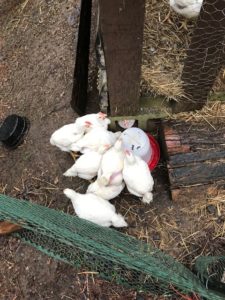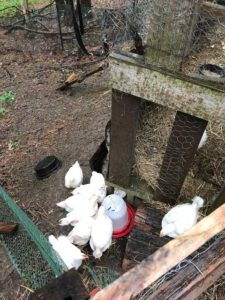I wanted to make a little post regarding some basic animal first aid that I feel folks should know regardless of the types/amount
Category: Chickens
Spring Butcher Day 2019
The meat birds are officially gone. We butchered all 19 remaining birds this past Sunday, 5/19. We started at 8 and were
Ascites in Meat Broilers
About 3 weeks ago, I noticed one of our broilers was gaping and having respiratory issues. I immediately began treatment with all manner of “natural” remedies, including VetRx (natural poultry respiratory aid), colloidal silver, and a natural dewormer on the chance it was gapeworm. While the bird didn’t exactly seem to be improving, it also did not seem to be getting worse. It was noticeable, however, that the bird was not growing like the others.
About a week ago I found the bird, freshly dead in the corner of the pen. Immediately I opened it up for autopsy. My first area to check was the esophagus/trachea, looking for signs of any gapeworm. All clear. The second I opened the body cavity however, a yellowish, gel-like fluid came out. It reminded me of a great bone broth after it’s been chilled. I was alarmed as I have never seen such a thing before. I took to Google, and found out that this happens in Cornish X, and it is called ascites.
Ascites is also known as water belly, and is found almost exclusively in meat birds. It is a form of congestive heart failure. The ‘jelly’ is an accumulation of protein-rich fluid in the body cavity. Short explanation, increased pressure within the veins causes blood pressure to rise and fluids leak from organs, primarily the liver, into the body cavity. The main cause is genetics.
Common signs include cyanosis (blue flesh), and respiratory issues (dyspnoea). They also tire easily and develop poorly. The best way to control ascites is to slow the growth rate of your birds by restricting feed and using low energy and protein diet. We did have the birds on high protein feed (the same as our entire flock, 22%), and in the spring we will use a lower protein 16-18% feed.
Learning something new every day!
Butcher Week

Then, Monday the pigs went to butcher. They loaded just fine, and the enclosure we made in the truck bed worked perfectly. When we arrived at the processors, the issue we had was unloading them. They didn’t want to get out of the truck bed, and unfortunately the worker was not patient and began shocking them with the cattle prod. This caused them to scream like no tomorrow. They finally unloaded down the ramp into the holding pen before being processed, but listening to them scream and seeing them be visibly distressed was awful. I put a lot of effort into ensuring that they had good lives, and that they were not stressed learning to load into the truck. They were very calm on the drive to the processor, but all in vain because of their stressful unloading experience. I only hope the meat is not negatively affected.

Monday night was a tough one for me. I was sad. I enjoyed having the pigs. Certainly, my wallet will be happier not having to feed them, but I miss their “talking,” and their eagerness to eat ANYTHING we put in the pen with them. It is so odd having an empty pig pen. I am keeping my eyes to the future though, the pig pen will become a mini orchard filled with dwarf fruit trees, berry bushes, and grape vines. It will become a turkey paddock in the spring of 2019 for our Thanksgiving turkeys. Our next batch of pigs will live in the woods, with more space and the ability to forage entirely. I am excited for the pork that we will receive from our first pigs, and I understand that I gave them a good life, and in death they will provide for us. I know that their lives were 1000x better than hogs raised in CAFOs, and their meat will be healthier for us.

Death is a part of life. No life exists without death, and we must all pay the toll one day.
Picture Perfect Weekend
We had some visitors this weekend, my father & his wife, along with my brother and my niece came down to visit! I love visitors. We had a fabulous time, and I love having my niece around to help me do chores. She’s a mini farmer in the making.
Saturday, before we went to the farmers market, I went and traded a trio of meat rabbits for a pair of green egg layers. One is black while the other is white, so naturally we named them Ebony & Ivory. They’ve already laid one dusty green egg. I am so excited! Now all we need are some blue layers and we will be set!
Our guests left this morning, prior to them leaving I showed my dad a quick rundown of posing & evaluating rabbits for quality. Upon their departure, I butchered three of our remaining 5 nine-week old kits. Two escaped freezer camp in order to have some grow out time so that we can see how they develop. I am fairly excited about the black doe that remains, I hope she turns into a nice girl. Her blue sister is also pretty promising.
After butchering, I dumped and cleaned feeders and waterers, and did a bit of grooming. Our rabbitry is now *almost* down to breeders only, we still have two of the older kits, and two of the 9 week olds remaining. We have managed to get all the rabbits moved into the main, fenced part of the rabbitry now, for easier management.
We also have a broody hen. Bertha, one of our new additions from January, is sitting on 5 eggs. She has been brooding them overnight for about 2 days, and now she is sitting on them longer & longer. I have toyed with the idea of putting the lone Polish chick under her, but she’s a young and inexperienced hen, so I’ll see if she manages to hatch anything herself. She’s quite the grump these days.
Butcher Day!!
My friend Sandra Walker (she led our soap making workshop) brought over her chicken plucker and graciously offered her assistance with the process. She has processed MANY birds for her family as well for retail sale, so I was very glad to have her guidance throughout the process.
We started around 08:30 and were finished by 10:00. Not too bad for two people (although Justus did the odd jobs we needed him to, like getting more hot water, salting the ice water, etc.) doing 11 birds!
It was somewhat bitter sweet, grabbing the first 4 birds and dispatching them, however once they were bled, plucked, & eviscerated, they looked lovely and were hardly recognizable as their living, bowling-ball type selves. The whole process for the birds was painless and as stress free as possible for them. Sandra has a fabulous butcher apron and I will totally be buying myself one.
We worked in batches of 4 birds – first dispatching (via cutting their throats and bleeding them out upside down), then plucking all 4 at once in the plucker, then cleaning & evisceration, & finally ice bath. I would say it took us about a half hour per set of 4, about 15 minutes total per person per bird – not too shabby.
I purchased some shrink bags and “official” labels so that if I decide to sell any to anyone, the safe handling instructions are included on the bird. Our final total cost came out to $81, or $6.75/bird (increased to $7.36 since we only were able to butcher 11). The average weight of the chickens was 4.74 lb (4lb 11.9oz), with the largest bird weighing 5.46 lb (5lb 7.4oz) & the smallest weighing 4.01 lb (4lb 0.2oz). This brings our price per lb (to break even) out to $0.64/lb. We have just over 52lb of meat from today, and I am beyond thankful. We’ve decided to sell any extra birds for $4.25/lb, averaging around $20 per bird for humanely raised & dispatched, pasture-raised, [organic] chicken.
I’ve included some photos of the whole process below, including the finished product. 🙂
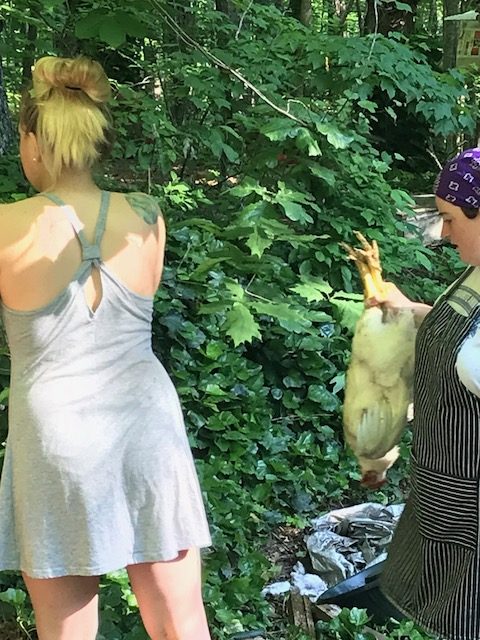
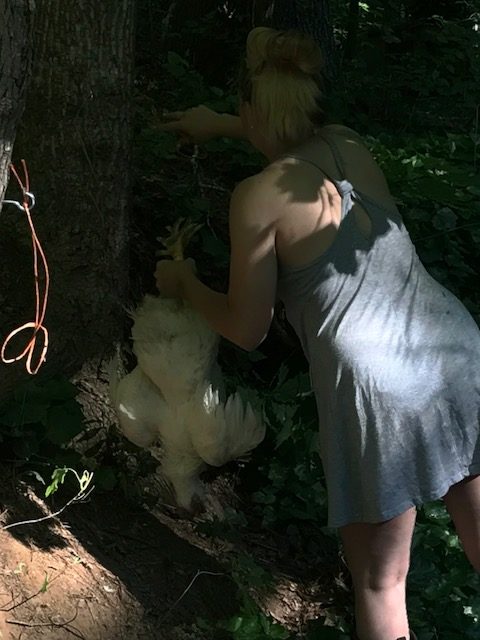
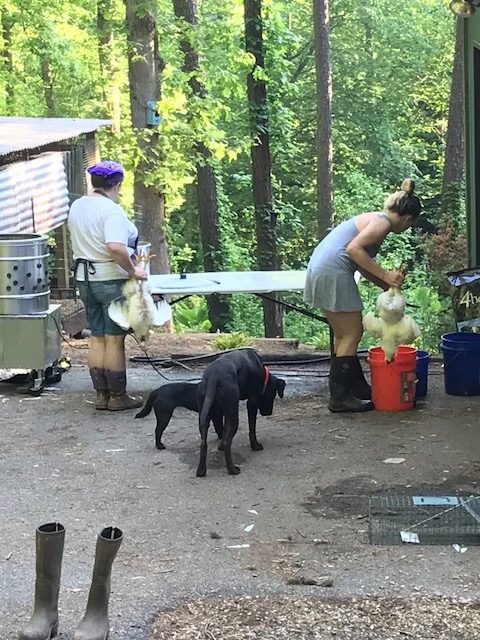
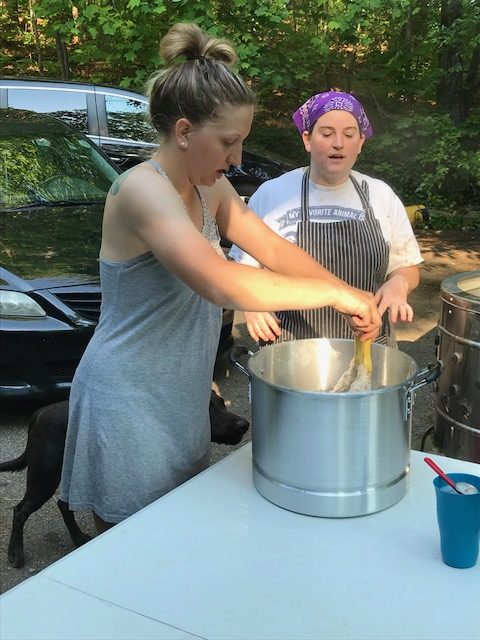
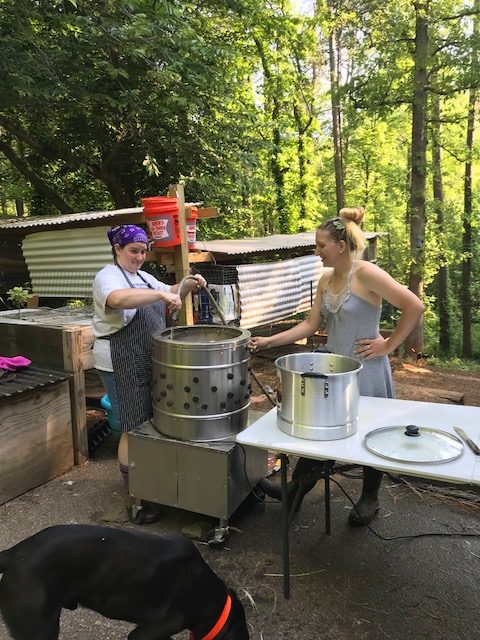
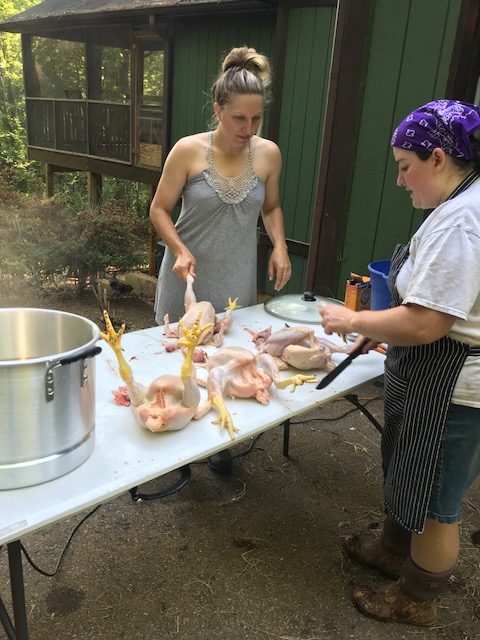
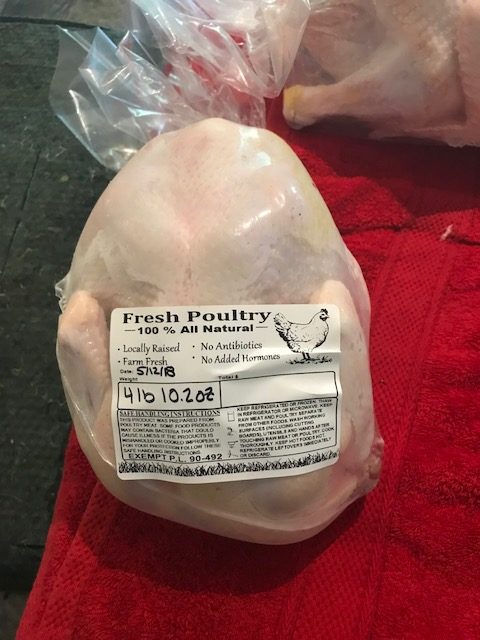
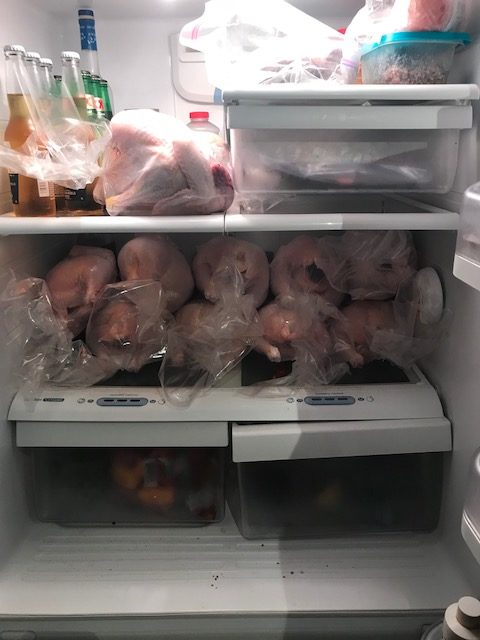
Meat Chickens: Week 8
It’s a bit bittersweet, I have really grown to like these big guys. They’re quite friendly and talkative. But I also understand that the Cornish X as a breed isn’t built to live beyond butcher age.
I was considering holding off until 10 weeks, but with temperatures rising and my out-of-town schedule becoming more & more hectic, I decided this weekend would be the weekend. They really won’t get much larger (if any), and I don’t see a point in increasing the feed bill for a very minimal gain.
So, I’ll feed them well today, give them their last bit of pets, and prepare myself for tomorrow.
Luckily for us, our friend is bringing her chicken plucker, so we should have all 11 butchered in no time. Our shrink bags and labels also arrived on time, so we will be able to do everything properly. Excited to weigh them tomorrow and see price per lb.
Our total investment has been $81, and final cost per bird comes out to $7.36 (should be $6.75 but we lost one chicken to the possum).
I’ll post a blog with some photos and our end products from butcher day tomorrow.
Meat Chickens: Week 7
They’re so (stupidly) friendly. And watching them waddle around is comical. They’re really acting like normal chickens now, despite looking like bowling balls with legs. When I walk up to their pen and say “Hello chickens,” they chirp back at me. I love to watch them take dust baths, and am enjoying my daily interactions with them.
There’s one cockerel who (I believe) must have been the first chicken the possum attempted to go after, before it succeeded in killing the one that it got. He has two little scratch marks/scars on his butt. I call him Scar Butt. He has no marks anywhere else, just looks like he got grabbed in the butt but got away. I haven’t decided if we will eat him yet or if he will have to go to the dogs – need to read up on that stuff. I assume if he doesn’t have an infection and is healthy otherwise, there should be no issue, just not sure I can eat something that a possum already took a bite out of, HA!
Enjoy a picture of myself & one of the pullets 🙂

Meat Chickens: Week 6
They’re super friendly and now they’re really foraging around their pen. They come running when I go out to feed them, since they aren’t free feeding now. They’re very curious and are not afraid of us or the dogs at all. They drink TONS of water too, much more than our other chickens, I’d imagine it’s something to do with how quickly they’re growing and how much they’re eating.

We did lose one. Found it under their coop, head missing, mostly eviscerated, broken legs. Not sure what got it, but we’ve set a trap and have not lost another one yet. They’ve got about two more weeks left until we process. Looking forward to more meat in the freezer.
Side note: yesterday and today I butchered our young rabbits & two of our new “accidental” roosters. The dogs have loved the past two days. I cooked one of the rabbits off with a pheasant in the crock pot to make some lovely broth and shredded the meat for future use.
P.S. The quail are laying again!!

Meat Chickens: Week 5
So far, our total investment is $56: $22 purchase, $34 in feed. Our cost per bird now at 5 weeks is $4.67. I’m very happy with that, and I’m even more anxious to see what our final cost per bird and cost per pound figures end up at.
I also learned that the reason they look so scraggly and naked and ugly is because they’re bred to have fewer feathers, for easier plucking. You learn something new every day.
